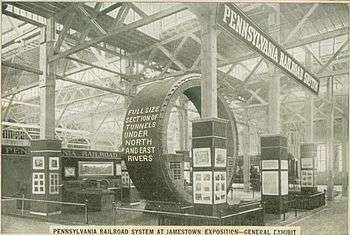East River Tunnels
 Construction of the East River Tunnels, 1909. | |
| Overview | |
|---|---|
| Line | Northeast Corridor and Long Island Rail Road |
| Location | East River between Manhattan and Queens in New York City |
| Operation | |
| Constructed | 1904-1909 |
| Opened | September 8, 1910[1] |
| Owner | Amtrak |
| Traffic | Rail |
| Character | Passenger |
| Technical | |
| Design engineer | Alfred Noble |
| Length | 3,949 feet (1,204 m)[1] |
| Width | 23 feet (7.0 m)[1] |
 East River Tunnels | |
The East River Tunnels are 4 single-track railroad tunnels that extend from the eastern end of Pennsylvania Station under 32nd and 33rd Streets in Manhattan and cross the East River to Long Island City in Queens. The tracks carry Long Island Rail Road (LIRR) and Amtrak trains travelling to and from Penn Station and points to the north and east. The tracks also carry New Jersey Transit trains deadheading to Sunnyside Yard. They are part of Amtrak's Northeast Corridor, so trains traveling between New York City and New England use the tunnels on their way to and from the Hell Gate Bridge.
History

The tunnels were built in the first decade of the 20th century as part of the Pennsylvania Tunnel and Terminal Railroad, providing a connection between the Pennsylvania Railroad's train station in New York City, Pennsylvania Station, and the railroad's Sunnyside Yard. The tunnels opened in 1910.[2] At that time the LIRR was a subsidiary of the Pennsylvania Railroad, and the tunnels allowed the LIRR its first of two direct accesses to Manhattan, the future East Side Access being the second.
The construction contract was awarded to S. Pearson and Son. The project was led by Chief Engineer Alfred Noble.[3] Work began in 1904[4]:111 and was completed by 1909. The four tunnels were built simultaneously, digging east from Penn Station, west from Long Island City, and east and west from shafts just east of First Avenue; they opened along with Pennsylvania Station in 1910. (Until 1910, LIRR trains ran to Long Island City, where passengers took ferries across the East River to the 34th Street Ferry Terminal in Manhattan.)
Operation
The East River Tunnels are currently owned by Amtrak and are electrified by both third rail and overhead catenary. Diesel-powered locomotives are not allowed in the tunnels except in emergency because of ventilation concerns, so the LIRR uses DM30AC dual-mode locomotives to power a few trains from non-electrified lines into and out of Penn Station during rush hours.
The four lines under the river are numbered south to north, Lines 1 and 2 running beneath 32nd St and Lines 3 and 4 under 33rd St. Eastward trains tend to use Lines 1 and 3, so to bring the two eastward lines together. Line 3 crosses beneath Line 2 underground a few hundred feet west of the east end of the Line 2 tunnel.
- East portals for Lines 1 and 3: 40°44′34″N 73°56′42″W / 40.7429°N 73.9450°W
- East portal for Line 2: 40°44′32″N 73°56′54″W / 40.7421°N 73.9483°W
- East portal for Line 4: 40°44′35″N 73°56′45″W / 40.74305°N 73.94585°W
Approaching Harold Interlocking from the west, the four tracks are Lines 1-3-2-4 south to north (with three LIRR tracks between Lines 2 and 3, and Sunnyside Yard approach tracks here and there). East of Harold, Lines 1-3 become LIRR Main Line Tracks 4-2 south to north, while Lines 2-4 become LIRR Main Line Track 3 and the westward Port Washington main. (Harold was rearranged in 1990; until then Lines 2-4 became the westward Port Washington and the westward Hell Gate track).
See also
- North River Tunnels (Hudson River tunnels to New Jersey)
- New York Tunnel Extension (construction project for East River Tunnels)
References
- 1 2 3 Guide to Civil Engineering Projects In and Around New York City (2nd ed.). Metropolitan Section, American Society of Civil Engineers. 2009. p. 58.
- ↑ Schafer, Mike; Brian Solomon (2009) [1997]. Pennsylvania Railroad. Minneapolis, MN: Voyageur Press. pp. 61–64. ISBN 9780760329306. OCLC 234257275.
- ↑ Brace, James (1912). "The East River Division". In Couper, William. History of the Engineering Construction and Equipment of the Pennsylvania Railroad Company's New York Terminal and Approaches. New York: Isaac H. Blanchard Co. p. 79.
- ↑ Gilbert, Gilbert H.; Wightman, Lucius I.; Saunders, William L. (1912). "The East River Tunnels of the Pennsylvania Railroad". The Subways and Tunnels of New York: Methods and Costs, with an Appendix on Tunneling Machinery and Methods and Tables of Engineering Data. New York: John Wiley & Sons. Retrieved 2009-10-11.
External links
- One Last Trick Up the Penn Station's Sleeve, The LIRR Today. February 27, 2014. (registration required)